Konstanz
![]()
The title of this article is ambiguous. For other meanings, see Constance (disambiguation).
Konstanz (pronunciation [ˈkɔnʃd̥ants], ![]() , standard German also [ˈkɔnstants], Alemannic [ˈkoːʃd̥əts, ˈxoʃd̥əts] and similar) is the largest city on Lake Constance and county seat of the district of Konstanz. The former free and at the same time imperial city belongs to the Federal Republic of Germany and is located on the border with Switzerland. Since 1 April 1956, Constance has been a large district town and forms a major centre within the Hochrhein-Bodensee region in the Freiburg administrative district of the state of Baden-Württemberg. Constance is home to two universities, the University of Constance and the University of Applied Sciences Constance Technology, Economics and Design (HTWG). The history of the town dates back to Roman times.
, standard German also [ˈkɔnstants], Alemannic [ˈkoːʃd̥əts, ˈxoʃd̥əts] and similar) is the largest city on Lake Constance and county seat of the district of Konstanz. The former free and at the same time imperial city belongs to the Federal Republic of Germany and is located on the border with Switzerland. Since 1 April 1956, Constance has been a large district town and forms a major centre within the Hochrhein-Bodensee region in the Freiburg administrative district of the state of Baden-Württemberg. Constance is home to two universities, the University of Constance and the University of Applied Sciences Constance Technology, Economics and Design (HTWG). The history of the town dates back to Roman times.

Constance old town with cathedral
Geography
Location
Constance is located on Lake Constance, at the outflow of the Rhine from the upper part of the lake directly on the border with Switzerland (Canton Thurgau). The Swiss neighbouring town of Kreuzlingen has grown together with Constance, so that the state border runs right through the middle between individual houses and streets, but also towards the Tägermoos along the border stream or Saubach. In good weather you can see the Alps, especially when the Föhn is blowing.
On the left (southern) side of the Rhine are the old town and the district of Paradies; the newer parts of town, on the other hand, are on the right (northern) side of the Rhine, on the Bodanrück peninsula between Untersee and Überlinger See. Constance's old town and the adjoining districts to the west are the only areas in Germany that lie south of the Seerhein, on the "Swiss side". This area is also - along with the Koller Island near Brühl - one of the two areas of Baden-Württemberg on the left bank of the Rhine.
The city area has 34 kilometres of shoreline and covers 1.31 km² of water surface. The lowest point is the lake level at 395 m above sea level (mean water level), the highest point at 570 m above sea level is at Rohnhauser Hof in Dettingen.
Neighboring communities
Neighbouring municipalities, i.e. municipalities directly bordering the urban area of Constance, are the municipality of Reichenau (mainland areas) and Allensbach in the Constance district as well as Kreuzlingen, Gottlieben (no land border, border runs in the middle of the Lake Constance), Tägerwilen (Tägermoos district) in the canton of Thurgau (Switzerland). Meersburg (Lake Constance district) is separated from Constance by Lake Constance, but is connected to Constance by a car ferry that runs around the clock with a 15-minute crossing.
City breakdown
Districts
The urban area is divided into 15 districts. Some of these are formerly independent communities that were incorporated into Constance, while others are districts whose names have evolved in the course of development or which were named after a particular reference point.
The 15 districts with area and population:
| No. | District | Area | Population | Region | Comments |
| 010 | Old Town | 129,1216 | 12.138 | left bank of the Rhine city centre | with the Niederburg including Dominikanerinsel, Stadelhofen, |
| 020 | Paradise | 63,2034 | 6.097 | left bank of the Rhine city centre | 19th century town extension to the west, former fishing village |
| 030 | Petershausen-West | 181,8892 | 16.021 | Urban fringe | Train station (DB, VHB) |
| 035 | Petershausen East | 163,4805 | 7.248 | Urban fringe | with Eichhorn, Musikerviertel, Salzberg, Sierenmoos |
| 040 | King's Building | 107,2120 | 6.181 | Urban fringe | with Pfeifferhölzle, Sonnenbühl, Sonnenhalde, Stockäcker |
| 050 | Allmannsdorf | 214,5832 | 5.348 | Urban fringe |
|
| 060 | Staad | 94,0913 | 1.779 | Urban fringe | Car ferry Constance-Meersburg |
| 070 | Fürstenberg | 175,8485 | 12.500 | Urban fringe | with Berchen area, Elberfeld; railway station (VHB) |
| 080 | Wollmatingen | 1026,0229 | 6.775 | Urban fringe | with Eichbühl, Öhmdwiesen; railway station (VHB) |
| 090 | Industrial area | 492,4143 | 1.048 | Urban fringe | with Oberlohn, Stromeyersdorf, Unterlohn |
| 100 | Egg | 314,2647 | 812 | Urban fringe | with Hohenegg, University of Konstanz |
| 110 | Litzelstetten | 511,3703 | 3.861 | Suburbs | with the former monastery St. Katharina and the island Mainau |
| 120 | Dingelsdorf | 643,4243 | 2.098 | Suburbs | with Oberdorf, Fließhorn (camping site), Klausenhorn (camping site) |
| 130 | Dettingen | 1075,6934 | 3.289 | Suburbs | with Dobel or Mühlhalden (former Dobel or Mühlhalder mill) and Rohnhauser Hof |
| 140 | Wallhausen | 174,9133 | 1.137 | Suburbs | with castle courtyard and brick courtyard |
|
| Constance | 5367,5329 | 86.332 |
|
The districts of Constance also have a long history. They belonged predominantly to the Reichenau Monastery and later came to the Mainau Kommende of the Teutonic Order and with it to Baden in 1805. Here they belonged to the office of Constance, from which the district of Constance emerged in 1939. Only the inner city (districts of Altstadt and Paradies) is on the left bank of the Rhine, all other districts are on the right bank. The changes and destruction caused by railway construction in the 19th century and retail trade and road construction in the 20th century are partly drastic.
See also: List of places in the district of Konstanz#Konstanz
City districts on the left bank of the Rhine
The district Altstadt goes - according to the classification by the city administration - far beyond the historic old town within the former city walls and includes a large part of what is counted as Paradies by the people of Constance. The Altstadt district therefore has considerably more area and inhabitants than the Paradies district, which is also on the left bank of the Rhine. Constance has repeatedly gained land by filling in the shallow water area of Lake Constance. Examples are the market place and the former fish market in the 13th and 14th centuries. Constance's old town is better preserved than those in many other cities in Germany, partly because it was not significantly damaged in either the Thirty Years' War or the Second World War. The number of preserved buildings from the Middle Ages, when the city experienced its heyday, is large.
The Niederburg within the old town is the oldest part. The area stretches between the cathedral, Konzilstraße, Seerhein and Unterer Laube, the former city moat. This is where the canons' courts settled near the cathedral. The Niederburg is home to the Niederburg Fools' Society. Today, the winding alleys are home to wine taverns, bookbinders, art glassmakers, other craftsmen, public authorities, the Dominican convent of Zoffingen, the district court, the notary's office, the Constance Municipal Theatre and the Constance Hospital Winery.
The suburb of Stadelhofen within the old town is bounded by Bodanstrasse, the Swiss border, the railway station area and Döbeleplatz. At the Schwedenschanze, the Swedes were prevented from conquering Constance during the Thirty Years' War. When Baden joined the German Customs Union, Stadelhofen temporarily became a customs exclusion zone. Georg Elser, whose assassination attempt on Hitler failed, was arrested at the Schwedenschanze during his escape - a bust commemorates him. The LAGO shopping centre with a supra-regional catchment area (including far into Switzerland) was built on Bodanstraße.
City districts on the right bank of the Rhine
Petershausen probably originated together with the monastery of the same name and was also an independent village community, which was, however, integrated into the city of Constance as a suburb as early as 1417, included in the city walls in the 15th century and administered by a captain. The associated imperial monastery of Petershausen was abolished in 1802 in the course of secularisation.
The Wollmatingen district was first mentioned in 724 as "VValamotinga", and in 811 as "Walmütingen".
Constance suburbs
The district of Staad, a former fishing village directly on the lake, has long been connected by the Constance-Meersburg car ferry to Meersburg, which lies on the other side of Lake Überlingen, which begins here.
The district of Allmannsdorf was first mentioned in 722 as "Alamantiscurt". It is located above Staad. Landmarks are the former town hall on Mainaustraße, the former water tower on Allmannshöhe (now a youth hostel) and the Loretto Chapel on Lorettohöhe, the Kreuzkirche was designed by Bauhaus student Hermann Blomeier.
From August 1947 until its demolition in December 1961, a barracks camp for East German expellees and refugees was located at Mainaustraße 252 in Egg with the aim of integrating them in Constance.
The suburb of Litzelstetten was first mentioned in 839 as "Luzzilonssteti". In the 14th century, the two villages "Oberdorf" and "Unterdorf" were distinguished.
The sub-village Dingelsdorf was first mentioned in 947 as "Thingoltesdorf", and Wallhausen, which lies behind it from Constance, was first mentioned in 1187 as "villa Walarhusin".
The suburb of Dettingen was first mentioned in 811 as "Tettingen". In 839 the village came to the monastery of Reichenau. In the 12th century, Reichenau ministerials ruled the village. There were two castles, Alt-Dettingen and Neu-Dettingen, which were abandoned by the 14th century at the latest. The Reichenau still held the high court over the village until the 18th century. The lower court had been under the jurisdiction of the Teutonic Order commandery of Mainau since the 15th century.
Local government districts
There are four parishes:
| Parcel no | District | Area in ha | Incorporation |
| 6660 | Constance | 3005 | Allmannsdorf 1 Jan. 1915Wollmatingen |
| 6661 | Dettingen | 1250 | 22 Apr. 1975 |
| 6662 | Dingelsdorf | 644 | 1 Jan. 1975 |
| 6663 | Litzelstetten | 512 | 1 Dec. 1971 |
|
| city of Constance | 5411 | - – |
| 6664? | Tägermoos | 154 | 28 March 1831 |
In addition, Tägermoos with an area of 154 hectares also belongs to Constance as a fifth district, but this is located on the left bank of the Rhine and on the territory of Switzerland. Its special status is laid down in a state treaty of 1831.
Localities
The former municipalities of Dettingen (today known as Dettingen-Wallhausen), Dingelsdorf and Litzelstetten are at the same time localities in the sense of the Baden-Württemberg municipal code, each with a local council and a local administration.
Regional planning
Constance is designated as a regional centre according to the regional development plan for Baden-Württemberg. This also assumes the tasks of the central area for the municipalities of Allensbach and Reichenau. In addition, there are links with the canton of Thurgau in Switzerland.
Climate
Due to its location on Lake Constance, Constance has a typical Lake Constance climate, which means that in winter it is somewhat milder than in most regions of Germany. In summer, however, high temperatures and little wind can easily lead to sultriness. As Lake Constance acts as a heat reservoir, there are relatively few frosty days in winter (approx. 80), but there are often large areas of fog and high snow, which often do not dissipate for days or even weeks. 95 of the average 160 cloudy days are in the months of October to February. There is a snow cover on about 30 days a year, mainly in January and February. These two months are also the coldest with 0.4 and 1.2 °C respectively. Warmest months are July and August with 18.7 and 18.1 °C respectively. With 946 mm of precipitation, Constance is one of the rainiest cities in Germany.
| Constance (442 m), 2015-2020 | ||||||||||||||||||||||||||||||||||||||||||||||||
| Climate diagram | ||||||||||||||||||||||||||||||||||||||||||||||||
| ||||||||||||||||||||||||||||||||||||||||||||||||
| Monthly average temperatures and precipitation for Constance (442 m), 2015-2020
Source: weatheronline.de - wetter.de | |||||||||||||||||||||||||||||||||||||||||||||||||||||||||||||||||||||||||||||||||||||||||||||||||||||||||||||||||||||||||||||||||||||||||||||||||||||||||||||||||||||||||||||||||||||||||||||||||||||||||||||||||||||||||||||||||||||||||||||||||||||||||||||||||||||||||||||||||||||||||||||||||||||||||
In Constance, too, the climate is visibly changing due to global warming. Records of the private weather station Kressbronn show that the temperature, compared to the measuring period 1981-2010, has increased by 0.5 °C in the years 2007-2014, the number of sunshine hours even by almost 360 to 2061 hours per year (WeatherOnline, however, only records an increase of about 110 hours). This makes Constance one of the sunniest cities in Germany.

Constance districts
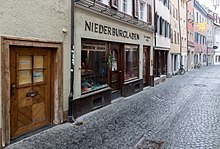
Rheingasse in the Niederburg
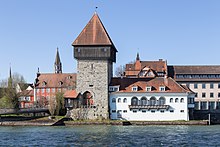
Rhine Gate Tower in Constance
.jpg)
Market place, central square and part of the pedestrian zone

The Imperia at the harbour entrance at Lake Constance, in the background the Alps
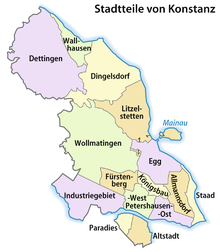
Districts of Constance

Panorama of Lake Constance from the steeple of Constance Cathedral
_Trichter.jpg)
View from the cathedral tower to the harbour and the Konstanz funnel, on the right the Konzilsgebäude. In the background Kreuzlingen
Religions and worldviews
Confession statistics
As of December 31, 2020, 33.2% of Constance residents were Roman Catholic, 19.9% were Protestant, and 46.8% belonged to another religion or denomination, were without affiliation to a religious community under public law, or did not specify. In 2011, the proportions according to the census were 39.2% Catholic, 24.0% Protestant and 36.8% either belonged to another religious denomination or to no religious denomination under public law or remained unspecified. The number of Catholics and Protestants has fallen steadily since 2000.
Christianity
Constance became the seat of a bishopric (Diocese of Constance) at the end of the 6th century, which belonged to the ecclesiastical province of Mainz. The city was the seat of an archdeaconry. From 1522 onwards, the Reformation initially found some adherents. The council even closed several monasteries in 1526 and Catholic services were banned in 1529. However, Constance had to return to the old faith (re-Catholicization) after its transfer to Austria in 1548. The majority of Protestants went to Switzerland. However, a small minority remained in the city. Nevertheless, Constance remained predominantly Catholic until the 19th century. In 1785, a Protestant community was again founded by immigrants from Switzerland, but was dissolved in 1796. In 1820, a Protestant community was established again.
The Catholic inhabitants belonged to the bishopric of Constance until 1821 and then came to the newly established archbishopric of Freiburg. This was created in the course of a sovereign church regiment initiated by the state, in order to henceforth have the bishopric borders coincide with the political borders of the Grand Duchy of Baden. The dissolution of the bishopric of Constance, whose historical territory extended far beyond Baden, was also due to the fact that the vicar general Ignaz Heinrich von Wessenberg, who had been elected bishop, was not accepted by the Vatican because of his liberal views. Constance became the seat of a deanery (see Archdiocese of Freiburg#Bishopric division).
Roman Catholic Church
In addition to the parish of the cathedral, several Catholic parishes developed in the course of history, some of which also go back to former monasteries. Today, there are the following Catholic parishes or communities in the city area, among others:
- Together with the parish of St. Stephan and the parish of St. Trinity, the cathedral parish forms the pastoral unit of Constance-Altstadt.
- The parish of St. Gebhard Petershausen together with the parishes of St. Suso and Bruder Klaus form the pastoral unit Konstanz-Petershausen.
- The parishes of St. Martin and St. Gallus together form the pastoral unit of St. Martin and St. Gallus.
- The parishes of St. Peter and Paul Litzelstetten, St. Verena Dettingen (with St. Leonhard Wallhausen) and St. Nikolaus Dingelsdorf (with St. Cross Oberndorf) also form a joint pastoral unit (Bodanrück).
These parishes or churches have partly a very old tradition. The church of St. Stephen was first mentioned in 615. At that time it was located south of the city and was possibly a cemetery church. In the 10th century it became the parish church of the civic community. The pillar basilica was remodelled in baroque style in 1770. The Holy Trinity Church was the church of an Augustinian monastery, which was dissolved in 1797. Then the church belonged to the hospital. In 1813 the parish was united with St. Jodok and Paul. At that time the church received a small tower. The former Jesuit church between the cathedral and the city theatre has been the parish church of the Old Catholic parish, founded in 1873, since 1904 as the Christuskirche.
The Catholic church of St. Gebhard, built in 1928/30 north of the former monastery of the same name, but which was already a parish in its own right in 1920, is more recent. Suso, built in 1937/38 and elevated to a parish in 1957 (new church built in 1975), the Bruder-Klaus-Kirche, built in 1955 as the first church in Constance after the Second World War and elevated to the parish of St. Nikolaus von Flüe in 1962, the church Maria-Hilf, built in 1967 (parish since 1970) and the church St. Gallus, built in 1971.
In the districts of Constance there are other Catholic parishes, which also belong to the deanery of Constance. The parish of St. Martin Wollmatingen has a church that was rebuilt in 1960. It still has Gothic elements. In former times Allmannsdorf also belonged to Wollmatingen. However, the church there of St. George, Our Lady, Peter and Paul, Pancratius and Martin was probably elevated to a parish in the 16th century. The Catholic church of St. Verena Dettingen was initially a branch of Dingelsdorf and was elevated to a parish in 1740. The late Gothic church was remodeled in baroque style in 1779. The chapel of St. Leonhard Wallhausen, which belongs to the parish, was built in 1714. The Catholic church of St. Nikolaus Dingelsdorf is a late Gothic hall church with a later west tower. The Catholic Church of St. Peter and Paul Litzelstetten was initially also a branch of Dingelsdorf and was elevated to a parish in 1826. The late Gothic church was remodeled in the 18th century in Baroque style, but the nave was torn down in 1978 and then rebuilt. The Mariae Himmelfahrts church on the island of Mainau, which formerly belonged politically to Litzelsstetten, was built between 1732 and 1739.
There are also other smaller churches and chapels. The Schottenkapelle on Schottenplatz served as a cemetery chapel in the Schottenfriedhof, which was Constance's main cemetery from May 1785 to April 30, 1870. Furthermore, the chapel of St. Martin in Paradise (built in 1922). The chapel of St. Lorenz on Obermarkt, probably built in the 13th century, was later converted into the town council chapel and profaned in 1839. For the numerous monasteries and monastery complexes, see the section on buildings.
![]()
Navigation bar Way of St James "Upper Swabian Way of St James
← Previous location: Staad | Konstanz | Next location: Konstanz Cathedral →
Location overview
Ulm Cathedral | Ulm | Grimmelfingen | Einsingen | Erbach | Donaurieden | Oberdischingen | Ersingen | Rißtissen | Untersulmetingen | Obersulmetingen | Schemmerberg | Äpfingen | Laupertshausen | Mettenberg | Biberach an der Riß | Reute | Grodt | Muttensweiler | Steinhausen | Wallfahrtskirche Steinhausen | Winterstettenstadt | Bad Waldsee | Bergatreute | Weingarten | Ravensburg | Brochenzell
Eastern route: Meckenbeuren | Tettnang | Gießenbrücke | Heiligenhof | Atlashofen | Hüttmannsberg | Gattnau | Arensweiler | Selmnau | Hattnau | Nonnenhorn
Western route: Rammetshofen | Unterteuringen | Hepbach | Leimbach | Möggenweiler | Markdorf | Meersburg | Lake Constance | Staad | Constance | Constance Minster
![]()
Navigation bar Way of St. James "Schwabenweg
← Previous location: Konstanzer Münster | Konstanz | Next location: Kreuzlingen →
Location overview
Constance Cathedral | Constance | Kreuzlingen | Bernrain | Schwaderloh | Ellighausen | Lippoldswilen | Märstetten | Amlikon | Affeltrangen | Tobel TG | Johanniterkommende Tobel | St. Margarethen TG | Münchwilen TG | Sirnach | Wiezikon | Oberwangen TG | Fischingen TG | Fischingen Monastery | Au TG | Hörnli | Fischenthal | Wald ZH | Rüti ZH | Jona SG | Rapperswil SG | Heilig Hüsli | Holzsteg over Lake Zurich | Hurden | Pfäffikon SZ | Etzelpass | Teufelsbrücke | Einsiedeln | Einsiedeln Monastery
Constance is a node in the network of the Way of St. James, which has as its destination Santiago de Compostela, located in Spain, where, according to legend, St. James the Elder is buried. The place is considered one of the most important pilgrimage destinations of Christianity.
The Upper Swabian Way of St James from Ulm and the Via Beuronensis from Tübingen end in Constance. As the Swabian Way, the Way of St James runs across the Swiss border into Thurgau and other Swiss cantons. The distance from Constance to Santiago de Compostela is 2340 kilometres.
Protestant Church
The Protestant congregation of Constance, founded in 1820, named itself after Martin Luther. The congregation first celebrated its services in the former Capuchin Church, then in the former Jesuit Church, before the Luther Church was built in 1873. In 1918 the Paulus parish was founded. In the 1930s, a wooden church was built in this parish, which was initially intended as a provisional structure. After successful renovation and redesigning of the interior, St. Paul's Church (wooden church) was again solemnly inaugurated on 1 Advent 2007 with great participation of the people of Constance. In 1947 the Ambrosius-Blarer parish split off from the Luther parish. Further parishes arose from the three parishes.
In Allmannsdorf a parish of its own was established in 1957. Previously, the Protestants were served by the Paulus parish of Constance. In 1958 Allmannsdorf received its own church (Kreuzkirche). From the Paulus parish the Petrus parish split off for the district Petershausen-West in 1974, for which an own church with community centre was built next to the main cemetery. On 1 Advent 2006, the two parishes of St. Paul and St. Peter were reunited to form a joint congregation, which bears the name "Evangelische Petrus und Paulus-Gemeinde Konstanz". The Protestants in Wollmatingen were also initially served by the Paulus parish. In 1935 an own parish was founded after the own church had been built in 1934. The parish is divided into the Christuspfarrei and the Johannespfarrei, which was separated from it in 1976. Both parishes have been reunited in a group ministry since 2010. Litzelstetten was also served by Wollmatingen; in 1969/70 the village received its own church (Auferstehungskirche), at which a separate parish was established in 1971. The Protestants of Dettingen and Dingelsdorf are served by the neighbouring parish of Allensbach. All the above-mentioned Protestant parishes in the Constance urban area belong to the Constance deanery of the Protestant Church in Baden with the deanery seat in the Wollmatinger parish.
Association of Evangelical Free Churches
The Association of Protestant Free Churches is represented by four congregations in Constance. It includes the Evangelical Free Church Baptist congregation on Lorettosteig, the Adventist congregation on Schottenstraße, the Evangelical Methodist congregation Am Briel, as well as the Hillsong Church Germany e. V. on Schneckenburgstraße, which belongs to the Federation of Free Church Pentecostal congregations (BFP).
More churches
In addition to the churches and free churches mentioned above, there is also an Old Catholic parish in Constance in the Christuskirche. In the first years after its foundation (1874) it comprised about 60% of the population of Constance.
The house of worship of the Independent Evangelical Lutheran Congregation is the Schottenkapelle in Schottenstraße, the congregation bears the name Evangelical Lutheran Markusgemeinde.
Other religious communities with Christian roots
Jehovah's Witnesses, the New Apostolic Church and the Church of Jesus Christ of Latter-day Saints are also represented in Constance.
Judaism
In medieval Constance, Jews were at times highly welcome, but at times also the target of persecution. In the period around 1200 to about 1450 they were granted civil rights and took part in the daily life of the city of Constance. Many Jews lived in the Münzgasse, where traces of a mikveh can still be seen today. The synagogue also stood in the old town.
The Pulverturm, situated on the Seerhein, used to be called the "Judenturm", because the Jewish population of the town was imprisoned several times and had to eke out an existence in this tower, sometimes for years. In 1537, during the Reformation, the Jewish community was completely expelled. It was not until 1847 that a Jewish settlement was again permitted in Constance; in 1862 the Emancipation Law came into force in Baden, whereupon the Israelite religious community was re-established in Constance in 1863. In 1875 it had 251 members, in 1895 already 528, about 2.5% of the city population. In 1882/83 a synagogue was built in the city on today's Sigismundstraße. In 1936 an arson attack was carried out on the synagogue; during the Reich Pogrom Night in 1938 it was set on fire and finally destroyed by the SS Verfügungstruppe III./SS-VT "Germania" stationed in Radolfzell. Diagonally opposite the former synagogue, directly behind the Church of the Holy Trinity, there is a memorial to the 108 citizens of Constance who were deported to the Gurs internment camp in southern France on 20 October 1940 because of their Jewish faith as part of the so-called Wagner-Bürckel action and murdered in the Auschwitz-Birkenau or Sobibor extermination camps.
On the site of the synagogue, the Jewish businessman and founder of the Constance Jewish community, Sigmund Nissenbaum (1926-2001), built a residential and office building in the 1960s, which also contains a prayer room. The Jewish community became independent in 1986 and had about 50 members in 1989. Due to the growing Jewish life in Konstanz after the immigration of Jews from the former Soviet Union in the 1990s, the number of members has grown to 320 in 2018.
In 1999, the prayer room was expanded into a small synagogue, which, like this one, has been at the disposal of today's Jewish Community of Constance K.d.ö.R. (IKG) since the 1960s. Services are held every Shabbat and on all Jewish holidays. Here at Sigismundstraße 19 are also the community office and community centre of the IKG, as well as the Dr.-Erich-Bloch-und-Lebenheim library (Judaica) of the Jewish Community.
For a number of years, the prayer room of the liberal Jewish community, which was also supported by the Upper Council of the Israelites of Baden, was located at the Obere Laube.
The disagreement between the two organizations (Israelitische Kultusgemeinde and Jüdische Gemeinde in Gründung) (among other things, about the role of women in the community) has long delayed the construction of a new synagogue on a plot of land provided by the city.
The synagogue community offers its members a wide range of learning opportunities in Torah and tradition, conducts services on Shabbat and all Jewish holidays, and offers programming for children, students, and seniors. The university group Morasha Konstanz at the University is affiliated with the congregation and represents students and young professionals in Konstanz. Morasha Konstanz belongs to Morasha Germany and is part of the Bund jüdischer Studenten Baden (BJSB).
On 9 November 2016, construction work began on a new synagogue and mikvah at Sigismundstraße 8, not far from the site of the synagogue destroyed in 1938 at Sigimsundstraße 19. The client was the Jewish Religious Community of Baden. The city of Constance provided the building plot free of charge and contributed 155,000 euros to the construction costs of 5 million euros. On November 10, 2019, the 81st anniversary of the destruction of the Old Synagogue in 1938, the New Synagogue Constance was ceremoniously inaugurated in the presence of numerous guests of honor. Speakers included the Vice President of the Central Council of Jews in Germany, Abraham Lehrer and Baden-Württemberg's Prime Minister Winfried Kretschmann. In a procession of joy, the Torah scrolls were symbolically carried from the site of the former synagogue to the new building in Sigismundstraße, about 50 meters away.
Islam
In October 2001, the Mevlana Mosque of the Turkish-Islamic community (Ditib) was opened in the Petershausen district. Thus, the approximately 3,000 Muslims in Constance have their own house of prayer with a 225 square metre prayer room, a dome with a diameter of ten metres and a 35 metre high minaret, one of the highest in Germany.
Buddhism
The Karma Kagyu Buddhist Diamond Way Centre, founded by Ole Nydahl and under the spiritual patronage of the 17th Karmapa Thaye Dorje, has existed in Constance since 1984. In addition, there are groups of other Buddhist directions.
Freemasonry
Several Masonic lodges exist in Constance. The Johannisloge Constantia zur Zuversicht is subordinate to the Grand Lodge of the Old Free and Accepted Masons of Germany. It is a registered society since 1909 in Schottenstraße 69 with 40 members and openness to a principle of higher order. The Perfection Lodge Jan Amos Comenius and the Sovereign Chapter Pons Libertatis, work according to the Ancient and Accepted Scottish Rite. The Women's Lodge Three Lights to the Lake is the first and so far the only Women's Lodge on Lake Constance. On the island of Mainau, the Swedish Rite is represented by the Bernadotte family. The Constance Lodges in particular maintain close relations with Switzerland.
Druids
The Lodge Imperia zu Konstanz of the Druids in the Constance district of Paradies is committed to fraternity, charity, human rights, tolerance and charity, i.e. humanity.
Evolutionary Humanism
The Giordano Bruno Foundation, which represents Evolutionary Humanism, is represented by the gbs-Bodensee e. V., founded in Constance in 2017, and aims to provide "a counterweight to religious, especially fundamentalist, organizations and movements."
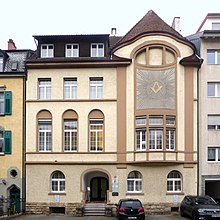
Constance, Schottenstraße 69: Lodge house of the Johannis Lodge Constantia zur Zuversicht

The New Synagogue Constance, Sigismundstr. 8, on the evening before the inauguration on November 10, 2019.
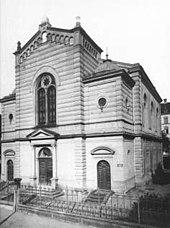
The Old Synagogue of Constance (1883-1938), Sigismundstr. 19, around 1930
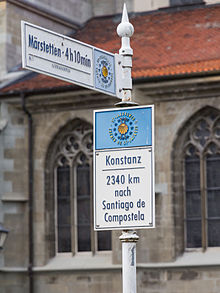
Way of St. James/Swabian Way, start at Constance Cathedral
_Plan_von_CONSTANZ_(1844).jpg)
Plan of the old town of Constance (1843)

The Constance Minster
Search within the encyclopedia